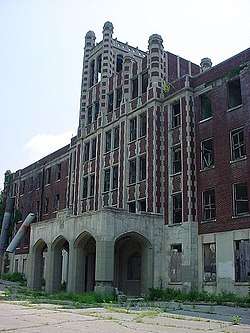Waverly Hills Sanatorium
The Waverly Hills Sanatorium is a former sanatorium located in southwestern Louisville/Jefferson County, Kentucky.
| Waverly Hills Sanatorium | |
|---|---|

| |
| Geography | |
| Location | Kentucky, United States |
| Organization | |
| Type | Specialist |
| Specialty | tuberculosis sanatorium |
| History | |
| Opened | 1910 |
| Closed | 1961 |
| Links | |
| Lists | Hospitals in Kentucky |
Waverly Hills Tuberculosis Sanatorium Historic Buildings | |
 Waverly Hills Sanatorium main entrance | |
| Location | 4400 Paralee Dr., Louisville, Kentucky |
| Architect | James J. Gaffney, Dennis Xavier Murphy |
| MPS | Jefferson County MRA |
| NRHP reference No. | 83002746[1] |
| Added to NRHP | July 12, 1983 |
It opened in 1910 as a two-story hospital to accommodate 40 to 50 tuberculosis patients. In the early 1900s, Jefferson County was ravaged by an outbreak of tuberculosis (the "White Plague") which prompted the construction of a new hospital. The hospital closed in 1961, due to the antibiotic drug streptomycin that lowered the need for such a hospital. Plans have been developed to convert the sanatorium into a hotel and conference center.[2][3][4]
History
The land that is known today as 'Waverly Hill' was purchased by Major Thomas H. Hays in 1883 as the Hays' family home. Since the new home was far away from any existing schools, Mr. Hays decided to open a local school for his daughters to attend.[5] He started a one-room schoolhouse on Pages Lane and hired Lizzie Lee Harris as the teacher.[5] Due to Miss Harris' fondness for Walter Scott's Waverley novels, she named the schoolhouse Waverley School.[5] Major Hays liked the peaceful-sounding name, so he named his property Waverley Hill. The Board of Tuberculosis Hospital kept the name when they bought the land and opened the sanatorium.[5] It is not known exactly when the spelling changed to exclude the second "e" and became Waverly Hills. However, the spelling fluctuated between both spellings many times over the years.[6][7][8]
Original sanatorium
In the early 1900s, Jefferson County was severely stricken with an outbreak of tuberculosis. There were many tuberculosis cases in Louisville at the time because of all the wetlands along the Ohio River, which were perfect for the tuberculosis bacteria. To try to contain the disease, a two-story wooden sanatorium was opened which consisted of an administrative/main building and two open air pavilions, each housing 20 patients, for the treatment of "early cases".
In the early part of 1911, the city of Louisville began to make preparations to build a new Louisville City Hospital, and the hospital commissioners decided in their plans that there would be no provision made in the new City Hospital for the admission of pulmonary tuberculosis, and the Board of Tuberculosis Hospital was given $25,000 to erect a hospital for the care of advanced cases of pulmonary tuberculosis.[9]
On August 31, 1912, all tuberculosis patients from the City Hospital were relocated to temporary quarters in tents on the grounds of Waverly Hills pending the completion of a hospital for advanced cases.[9][10] In December 1912 a hospital for advanced cases opened for the treatment of another 40 patients. In 1914 a children's pavilion added another 50 beds[11] making the known "capacity" around 130 patients.[12] The children's pavilion was not only for sick children but also for the children of tuberculosis patients who could not be cared for properly otherwise. This report also mentions that the goal was to add a new building each year to continually grow so there may have even been more beds available than specifically listed.
Sanatorium expansions
Due to constant need for repairs on the wooden structures, need for a more durable structure, as well as need for more beds so that people would not be turned away due to lack of space,[13] construction of a five-story building that could hold more than 400 patients began in March 1924. The new building opened on October 17, 1926, but after the introduction of streptomycin in 1943, the number of tuberculosis cases gradually lowered, until there was no longer need for such a large hospital. The remaining patients were sent to Hazelwood Sanatorium in Louisville. Waverly Hills closed in June 1961.
Woodhaven Medical Services
The building was reopened in 1962 as Woodhaven Geriatric Center, a nursing home primarily treating aging patients with various stages of dementia and mobility limits, as well as the severely mentally handicapped. However, Woodhaven failed greatly because it was severely understaffed and overcrowded. Woodhaven also had reports over patient neglect and was closed by the state of Kentucky in 1982 .[14]
Prison
Simpsonville developer J. Clifford Todd bought the hospital in 1983 for $3,005,000. He and architect Milton Thompson wanted to convert it into a minimum-security prison for the state, but the developers dropped the plan after neighbors protested. Todd and Thompson then proposed converting the hospital into apartments, but they counted on Jefferson Fiscal Court to buy around 140 acres (57 ha) from them for $400,000, giving them the money to start the project.[15]
Statue
In March 1996, Robert Alberhasky bought Waverly Hills and the surrounding area. Alberhasky's Christ the Redeemer Foundation Inc. made plans to construct the world's tallest statue of Jesus on the site, along with an arts and worship center. The statue, which was inspired by the famed Christ the Redeemer statue on Corcovado Mountain in Rio de Janeiro, would have been designed by local sculptor Ed Hamilton and architect Jasper Ward.[16] The first phase of the development, coming in at a cost of $4 million, would have been a statue of 150 feet (46 m) tall and 150 feet (46 m) wide, situated on the roof of the sanatorium. The second phase would convert the old sanatorium into a chapel, theater, and a gift shop at a cost of $8 million or more.[17]
The plan to construct this religious icon fell through because donations to the project fell well short of expectations. In a period of a year, only $3,000 was raised towards the project despite efforts to pool money from across the nation. The project was canceled in December 1997.[17]
Tunnel
The tunnel was an entrance and exit for the workers of the sanatorium. It was built on the first floor with the rest of the building. The corridor is 500 feet to the bottom of the hill and has a set of stairs on one side, which were the stairs used for the workers. On the other side, there was a cart that moved up and down the stair case which transported supplies and other necessities.
Since antibiotics did not exist in the time that the sanatorium was active, other forms of aid were used to treat TB patients. For example, heat lamps, fresh air, and positive talk and reassurance helped to keep patients alive, since the death rate of TB patients at the time was one death per day. However, at the peak of the disease, the sight of the dead being carried away in full view of the patients lowered the patient morale, increasing the number of deaths per day. Therefore, the sanatorium tried transporting the dead bodies as secretively as possible to increase the morale and lower the death rates, using the tunnel to that end. The doctors and workers of this time also believed that this would help to lower the disease's spreading rate.[14]
Restoration
After Alberhasky's efforts failed, Waverly Hills was sold to Tina and Charlie Mattingly in 2001. The Mattinglys hold tours of Waverly Hills and host a haunted house attraction each Halloween, with proceeds going toward restoration of the property. They're also currently restoring all the windows in the decrepit building while restoring the interior of the old sanatorium.[18][19]
Sounds of the Underground Music Festival
Waverly Hills Sanatorium hosted the last show of the touring music festival Sounds of the Underground 2007 on August 11. The show featured prominent acts in the extreme metal and metalcore scene, including Job for a Cowboy, The Acacia Strain, Hatebreed, Shadows Fall, Chimaira, GWAR, Cameo, Lamb of God and The Number Twelve Looks Like You. Similar festivals or concerts will likely not happen again at the Waverly Hills Sanatorium, due to complaints made by local residents.[20]
Waverly Hills Today
The old sanatorium is owned today by private investors who open the historic building up to curious overnight guests and "ghost" tours. The tours inform guests of the building's origin and history.[14]
On television
Waverly Hills has been popularized on the television show Ghost Hunters as being one of the "most haunted" hospitals in the eastern United States.
The sanatorium was featured on ABC/FOX Family Channel's Scariest Places on Earth, VH1's Celebrity Paranormal Project, Syfy's Ghost Hunters, Zone Reality's Creepy, the British show Most Haunted, Paranormal Challenge, Ghost Adventures on Travel Channel[21], and in episode 18 ("The Bull and the Beautiful")[22] of season 3 of Animal Planet's series Call of the Wildman.[23] It was also featured on paranormal shows Ghost Asylum and Paranormal Lockdown; both on Destination America. It was also mentioned on The CW's show Supernatural in season 11, episode 23, "Alpha and Omega".
The Web-series Buzzfeed Unsolved visited the location in season 2 for one of their supernatural episodes. Timmy wants to play with Ryan.
See also
References
- "National Register Information System". National Register of Historic Places. National Park Service. January 23, 2007.
- Davis, Alex. "Spooky Waverly Hills may return as hotel", The Courier-Journal, August 7, 2008.
- Renovations hopeful for haunted hotel Archived January 13, 2009, at the Wayback Machine, Fox41.com
- "Waverly Hills is preparing to open for Halloween tours, but its owners still have bigger plans". Louisville Business First. Retrieved December 1, 2015.
- Detert, Fred. "How Waverly Hills Got Its Name", Waverly Herald, circa 1953.
- Postcard (with 2nd E), located in display case in the laundry building at Waverly
- Postcard (without 2nd E)
- Endowment booklet (with 2nd E)
- Report of Board of Tuberculosis Hospitals (1915). Freepages.history.rootsweb.com. Retrieved on 2011-11-27.
- "History of Waverly Hills", The Waverly Herald, pp. 3–4
- "History of Waverly Hills", The Waverly Herald
- Wilson, Dunning S.; Dittmar, L. J. Report of the Board of Tuberculosis Hospital, Dr. Dunning S Wilson was Medical Director of Waverly Hills. L. J. Dittmar was President of the Board of Tuberculosis Hospital.
- "Sanatorium Has Waiting List for Treatment, Effective In Early Stages", The Louisville Times, December 5, 1928.
- "Waverly Hills Sanatorium | Louisville Kentucky Paranormal Tours | Historical Photos". Waverly Hills Sanatorium | Louisville Kentucky Paranormal Tours. Retrieved November 5, 2018.
- "Famed hospital now a white elephant", The Courier-Journal, August 13–14, 1986, p.1.
- "World tallest Christ statue planned for Waverly Hills", The Courier-Journal [Louisville], March 1996: 1.
- "Jesus statue 'would take a miracle'." Kentucky Post December 12, 1997: 1.
- Seewer, John. "Haunted houses mix big-budget scenes and settings for ghoulish getaways", The Canadian Press, October 2, 2009.
- "Waverly Hills Sanatorium Haunted House", The Courier-Journal, October 3, 2009.
- "PLEASURE RIDGE PARK: Waverly Hills rock concert was its last: Neighbors outraged by noise, vulgarities", The Courier-Journal, August 22, 2007.
- Ghost Adventures : TV Shows. Travel Channel (February 28, 2011). Retrieved on 2011-11-27.
- Follow in the footsteps of Animal Planet's Turtleman, Lexington Herald Leader, May 31, 2013, retrieved February 24, 2019
- Call of the Wildman Season 3 Episode 18: The Bull and the Beautiful, TV Guide, September 15, 2013, retrieved February 24, 2019